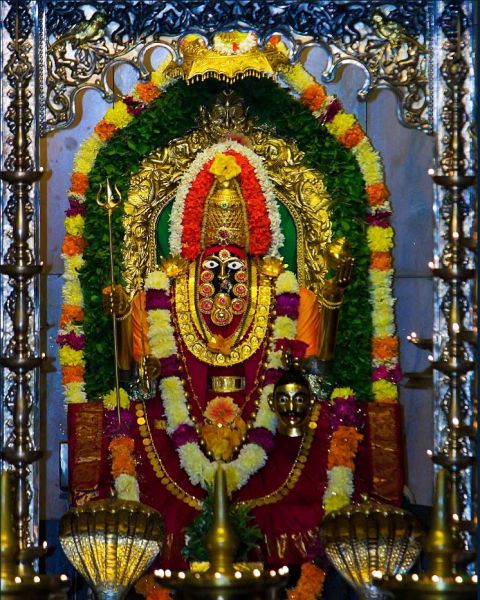Hardly one kilometre away from Mangueshi is the village Mardol where nestles the temple of Sri Mahalasa. While it is commonly understood that Mahalasa is a form of “Shakti”, “Madalasa” or “Narayani”, the deity is also being worshipped as the manifestation of Lord Vishnu as “Mohini”.
Sri Mahalasa Narayani Samsthan is the most important temple in Goa. It was originally located at Varunapur (Verna) in Sastri taluk. The Portuguese records say that it was one of the most brilliant temples destroyed by them. It was shifted to Antruj Mahal, Ponda in the16th century AD. Sri Shanteri and Sri Laxmi Narayana are affiliated deities along with Dhada. Shankar, Kala Bhairav, Bhagwati and various family purushas are worshipped here. Navaratri Festival is celebrated with great pomp and show.
There are rooms in the temple with modern facilities in newly built Agrashalas. Goddess Mahalasa was a much-feared deity of the temple. Even Portuguese courts recognized the justice dispensed by taking oath under the “Justice Bell”.
A huge ‘Dipa Stambha’ made of five metals greets the visitors at the entrance of the temple, which was built in the 17th century. It has exquisite wooden carvings of ten incarnations of Lord Vishnu. Huge round pillars held the ‘Sabhamandapa’ at the entrance, which is being reconstructed to recapture the glorious past of the original temple situated at Verna in “Salcete Taluka”.
The opulent Mahalsa temple is one of the most famous temples in Goa. The temple is dedicated to Goddess Mahalsa, an incarnation of Lord Vishnu. Hence the temple is also as the Mahalsa Narayani temple, Narayan being another name for Vishnu. The Mahalsa temple is located one kilometer afar from the Mangueshi temple, another prominent temple in Ponda.
Another victim of the Portuguese excesses during the Inquisition, the deity of the Mahalsa temple was originally located in the village of Verna in Salcete taluka. With the threat of persecution looming large, devotees clandestinely transferred the idol across the river to the present location of Mardol.
The visually appealing outline of the temple is augmented by the six-storied ‘deepstambha’ or ornamental lamp pillar in the courtyard. This splendid pillar is 40 feet in height and has 21 rings of a hundred fifty small lamps. A fascinating spectacle unfolds when it is lit up with oil wicks on the annual festival day or Jatra. Apart from the Jatra, the Jaiyanchi Puja held in August and the Kojagiri Pornima are two other special occasions.
(via http://www.templemiracles.org/?p=908)


